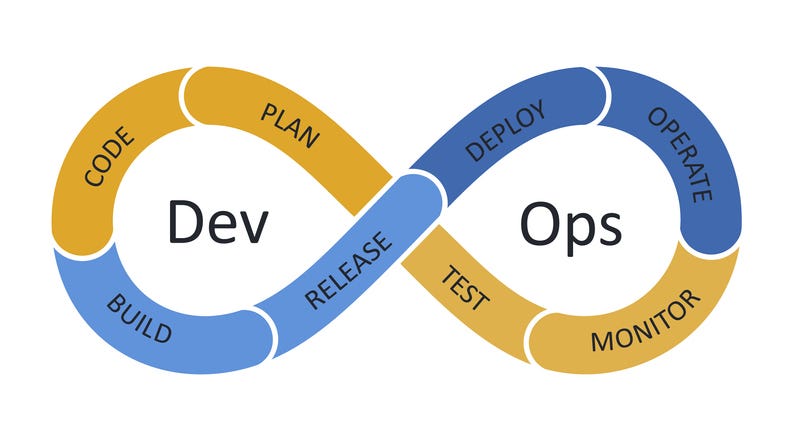What is DevOps 🤔?

In today’s fast-paced tech landscape, businesses are under constant pressure to deliver high-quality software quickly. But how do companies balance speed with stability? The answer lies in DevOps — a methodology that bridges the gap between development and operations teams to streamline software delivery.
If you’ve ever wondered what DevOps is, why it’s important, or how to get started, this blog will answer your questions. By the end, you’ll have a clear understanding of DevOps principles, tools, and its role in modern IT workflows.
What is DevOps?
DevOps is all about bringing people and processes together to make software development faster, smoother, and more reliable. Think of it as a way for developers and operations teams to break out of their silos and work as one big, efficient team. With DevOps, the focus is on teamwork, smart tools, and methods that simplify everyday tasks and get things done quicker.
Advantages of DevOps-
Faster Time-to-Market: Reduced Development Cycle in DevOps allows for faster and more frequent software updates by automating and streamlining the development, testing, and deployment processes.
Smart Automation: Tasks like testing, deploying code, or keeping systems running are handled by tools, so teams can focus on innovation instead of repetitive chores.
Always Improving: Feedback flows constantly, helping teams fine-tune software, fix bugs faster, and make the overall experience better for everyone.
Built-in Security: DevOps integrates security into every step of the process with practices like DevSecOps. Automated security scans, vulnerability checks, and regular updates ensure that applications are safe without slowing down development.
Why Devops is important in digital era ?
Before DevOps, traditional software development followed the Waterfall Model, where teams worked in silos. This approach often resulted in delayed releases, miscommunication, and production failures.
DevOps changes the cultural mindset: DevOps indeed plays a significant role in transforming the cultural mindset of an organization. It fosters a collaborative culture between development and operations teams, promoting shared responsibility for the software lifecycle, from development through to deployment and monitoring.
DevOps helps uncover patterns that help organizations improve: DevOps provides organizations with the tools to identify patterns in their processes and workflows. These insights allow businesses to optimize performance in the face of digital disruption. DevOps emphasizes continuous improvement through feedback loops, data-driven decision-making, and iterative processes, which help organizations stay competitive and adaptable in a rapidly changing digital landscape.
DevOps helps teams self-steer toward better solutions : DevOps plays a pivotal role in enabling teams to self-steer toward better solutions by fostering autonomy, collaboration, and continuous improvement.
DevOps makes automation a priority: it is one of the key enablers of the speed, efficiency, and consistency that DevOps aims to achieve. Automation helps reduce manual effort, eliminate human error, and ensure that repetitive tasks are executed in a fast and reliable manner. Here’s how automation is prioritized and why it’s vital in the DevOps pipeline:
1. Continuous Integration and Continuous Deployment (CI/CD)
CI/CD pipelines are at the heart of DevOps automation. Continuous integration involves automatically testing and merging code changes into the main branch, while continuous deployment ensures that the application is automatically deployed to production after passing tests.
Automation in CI/CD allows for faster, more frequent releases without the risks of manual errors. It speeds up the development cycle, allowing teams to deliver new features and bug fixes quickly and consistently.
2. Automated Testing
Automated testing is essential for ensuring that code is functioning as expected at every stage of the pipeline. With unit tests, integration tests, and end-to-end tests, DevOps teams can catch issues early in the development process.
By automating tests, teams can achieve higher test coverage and faster feedback loops, ensuring that bugs are detected and resolved before they make it to production.
3. Infrastructure as Code (IaC)
IaC is a core practice in DevOps, where infrastructure management (such as provisioning and configuring servers, networks, and databases) is automated using code.
Tools like Terraform, Ansible, and CloudFormation allow teams to define infrastructure in configuration files. This automation ensures that environments are consistent, reproducible, and scalable.
IaC also enables version control of infrastructure, allowing teams to track changes and roll back to previous configurations when needed.
DevOps Lifecycle:

1. Plan
Teams define project goals, gather requirements, and plan development cycles using tools like Jira or Trello.
2. Code
Developers write and manage code using version control systems like Git and GitHub.
3. Build
CI tools like Jenkins or GitLab automate the process of building and testing applications.
4. Release
Containerization tools like Docker package the application, making it portable and ready for deployment.
5. Deploy
Orchestration tools like Kubernetes or Ansible manage the deployment of applications across environments.
6. Monitor
Continuous feedback from monitoring helps teams address issues and improve future releases.
7. Operate
Monitoring and logging tools like Grafana or Prometheus ensure the application runs smoothly in production.